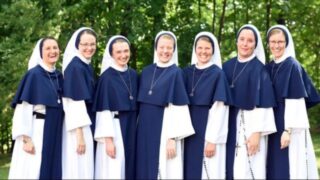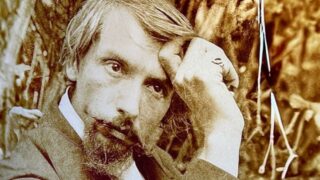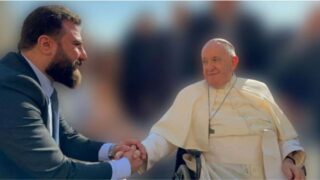According to the German Pope, churches and civic buildings of old expressed both the ideal of magnificence and a hope for social harmony.
by Massimo Introvigne
Article 2 of 3. Read article 1.


While the speech to the artists of 2009 discussed in the first article of this series is the Magna Charta of Benedict XVI’s Catholic theology of the arts, in other texts the German Pope further illustrated his aesthetic ideas by examining specific works of art, including of architecture.
A concrete example of how the “via pulchritudinis,” the path to beauty, works in history is given according to Benedict XVI by the Romanesque and Gothic cathedrals of the Middle Ages, to which three days before the meeting with the artists Benedict XVI consecrated another interesting speech, at the general audience of November 18, 2009.
Here the German Pope discussed the history of Romanesque and Gothic art, and illustrated the cultural, social and technical reasons for the transition from one to the other. The speech should really be read in its entirety. Here, however, I would like to emphasize—because of the connection with the November 21, 2019, speech to the artists—two key points.
The first is that for Benedict, as much as it is historically important to study the technical and social context of Romanesque and Gothic art and cathedrals, it should not be forgotten that the purpose of the cathedral builders was not cultural but religious. “All was oriented and offered to God, Benedict said, in the place in which the Liturgy was celebrated. We may understand better the meaning attributed to a Gothic cathedral by reflecting on the text of the inscription engraved on the central portal of Saint-Denis in Paris: ‘Passerby, who is stirred to praise the beauty of these doors, do not let yourself be dazzled by the gold or by the magnificence, but rather by the painstaking work. Here a famous work shines out, but may Heaven deign that this famous work that shines make spirits resplendent so that, with the luminous truth, they may walk toward the true light, where Christ is the true door.’”


“The masterpieces of art created in Europe in past centuries, Benedict went on to say, are incomprehensible unless one takes into account the religious spirit that inspired them. Marc Chagall [1887–1985], an artist who has always witnessed to the encounter between aesthetics and faith, wrote that ‘For centuries painters dipped their brushes into that colorful alphabet which was the Bible.’ When faith, celebrated in the Liturgy in a special way, encounters art, it creates a profound harmony because each can and wishes to speak of God, making the Invisible visible.”
The second core aspect Benedict emphasized in the November 18, 2009, speech about the cathedrals is that the religious reference is not only the key to understanding the works of art of the cathedral age in themselves, and how and from where they came into being. It is also the right way to enjoy them, and to make their contemplation an element of our spiritual life.
“The strength of the Romanesque style and the splendor of the Gothic cathedrals, Benedict said, remind us that the ‘via pulchritudinis,’ the way of beauty, is a privileged and fascinating path on which to approach the Mystery of God. What is the beauty that writers, poets, musicians, and artists contemplate and express in their language other than the reflection of the splendor of the eternal Word made flesh? Then St Augustine [of Hippo, 354–430] says: ‘Question the beauty of the earth, question the beauty of the sea, question the beauty of the air, amply spread around everywhere, question the beauty of the sky, question the serried ranks of the stars, question the sun making the day glorious with its bright beams, question the moon tempering the darkness of the following night with its shining rays, question the animals that move in the waters, that amble about on dry land, that fly in the air; their souls hidden, their bodies evident; the visible bodies needing to be controlled, the invisible souls controlling them. Question all these things. They all answer you, -Here we are, look; we’re beautiful!- Their beauty is their confession. Who made these beautiful changeable things, if not one who is beautiful and unchangeable?’”


Interestingly, beauty here is not only artistic. There is a beauty of the natural world, a beauty of the artistic works created by humans, and even an institutional beauty of a honest and well-ordained social life. Again in, 2009, in his September 30 audience in St. Peter’s Square, in which he commented his trip to the Czech Republic, Benedict XVI reflected on the beauty of Prague and in particular its castle, which then is not just a castle but a set of interconnected buildings.
“Prague Castle, he said, extraordinary from the historical and architectural viewpoints, suggests a further, more general reflection: its vast layout includes many monuments, scenes and institutions, almost as if it represented a ‘polis’ in which the Cathedral and Palace, square and park, harmoniously coexist.” There is here a profound lesson on the possible, if difficult, beauty not only of buildings but of institutions that try to guarantee harmony and peace, including peace between religious and secular institutions (that it was not always so, including in Prague, is something Benedict was well aware of, as testified by his speeches in the Czech Republic in that same year 2009).


On May 13, 2012, while visiting the Italian town of Sansepolcro, Benedict XVI proposed the theme of the beauty of cities through the extraordinary history (or perhaps legend) of its founders Aegidius and Arcanus. They lived at the turn of the year 1000 and went on a pilgrimage to the Holy Land. There, Benedict said, they “began to search for the truth and the meaning of life. On their return, they brought with them not only the stones gathered on Mount Zion but the unique idea they had thought of in the Land of Jesus: building on the Upper Tiber Valley an image of Jerusalem, a ‘civitas hominis’ which in its very name, recalls justice and peace. A plan that evokes St Augustine’s great view of history in the work ‘De civitate Dei’ [The City of God].”
According to the traditional story, Aegidius and Arcanus collected in Jerusalem on the sites of Christ’s Passion stones that they would place in the foundations of the buildings of their new city, arranged so that everything would converge toward the Cathedral, the “reference point from which everyone can direct their journey,” which will be embellished by later art. Next to it stands the City Hall, in a square that expresses the hope of a “newfound harmony between moments of worship and civil life.”
Others may regard this harmony as a dream, or a Catholic utopia. Yet, the miracle of art is that it expresses in stones and colors hopes that it is more difficult to encounter in real life.









